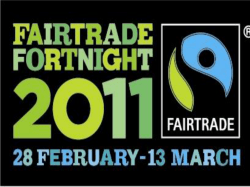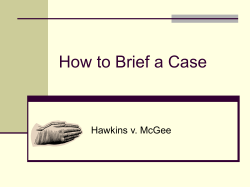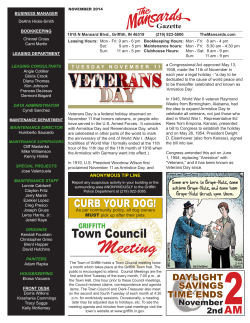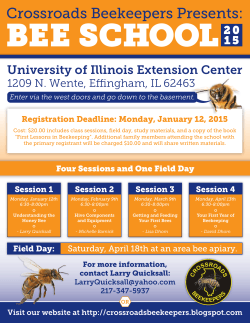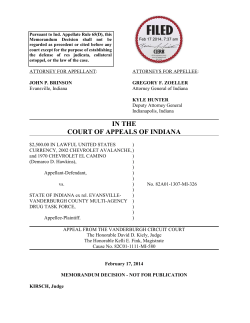
January 2015
P U B L I C S P E A K I N G 51 68 P U B L I C S P E A K I N G Words Nick Scott 8 WAYS TO BE A BETTER PUBLIC SPEAKER IN 2015 Being able to captivate an audience with a truly inspiring speech is arguably one of the few traditional business skills that has become more important today than ever before. Three public speaking experts offer their top tips for talking without the trepidation D GETTY IMAGES DIRECTOR DECEMBER 2014/JANUARY 2015 Speech secrets: business leaders can sharpen their public speaking skills by using simple techniques including calming nerves by controlling breathing and thorough preparation oes the thought of addressing a large room full of industry peers get you in a sweat? Then you’re not alone. Highly influential historical figures known to have been less than confident public speakers include former US president Thomas Jefferson and King George VI (as depicted in the film The King’s Speech). So often does speaking publicly top polls of people’s greatest fears, there’s even a word – glossophobia – for individuals who have a debilitating fear of taking to the lectern. Even if you’re already confident when it comes to engaging with people en masse, it can only pay to sharpen your skills – in our tech-saturated era of ever-diminishing concentration spans, being able to capture the attention of a crowd is arguably one of the most valuable skills a business leader can have. With that reality in mind, we asked three leading experts in the field – Nadine Dereza and Ian Hawkins, co-authors of Insider Secrets of Public Speaking, and Caroline Goyder, author of the aptly named Gravitas and a former Royal Central School of Speech and Drama teacher, for their best advice on how business leaders can brush up their oratory skills in 2015… 1 BE ASSERTIVE 2 OWN YOUR PERFORMANCE SPACE 3 SPEAK IN SHORT SENTENCES “Public speaking is an act of leadership, so be wary of letting anything undermine your authority,” says Hawkins. “Avoid opening with an apology and calm any nerves by controlling your breathing – otherwise the audience could stop listening to you and start worrying about you. When on stage, speak as though what you say makes a difference. You should know more about the subject than there is in the content of your speech. As well as maintaining the aforementioned confidence throughout the Q&A session, it’ll vastly improve your poise and assertiveness.” You know the old adage about failing to plan? According to Dereza – a regular business presenter – a successful public speech starts with the speaker arriving long before their audience, and getting to know the space in which he or she will be speaking. “Always check sound, lighting, and your PowerPoint presentation in advance,” says Dereza.” You’ll give a more confident presentation this way.” Encouragingly, another of the powerful historical figures for whom public speaking didn’t come naturally was a man who became renowned for his prowess as an orator: Sir DECEMBER 2014/JANUARY 2015 DIRECTOR “Think about who you’re talking to. You won’t please everyone all the time, but if you know what they’re expecting you’ll know what to deliver” Nadine Dereza, left Winston Churchill. The prime minister was so petrified of addressing a crowd, the first time he attempted it he lisped, stuttered and, eventually, fainted. And yet, according to Goyder, we have a lot to learn from him – not least the knack of keeping it pithy. “Churchill would send speeches back to his secretaries if they were typed in paragraphs,” she explains. “He would say, ‘that’s not a speech, it’s a magazine article’. Follow his lead and speak your speech as if it were a film script or play. Short, pithy lines, separated by clear punctuation, allows you and the audience to go one idea at a time, boosting your confidence and their attention.” 4 KEEP IT REAL The harsh reality is, say the experts, that if you try to emulate Barack Obama’s affable gravitas, you’ll be smelt out as a phony – your audience is likely to be very perceptive. “Be the best version of yourself, rather than a second-rate copy of someone else,” says Hawkins. “Audiences like to feel that they’ve been let in to see the real you. Get rid of the idea that to be a good speaker you have to use tricks; good speakers are themselves.” 5 WHEN YOU FALTER, ALTER “When practising, your aim should always be to get to the point where you can be largely script-free,” says Goyder. “This takes practice. Using a voice recorder, deliver the speech in sections, without notes, then listen back. Where you get stuck is usually where the sequence of ideas isn’t clear. Get the logical flow clear, and you will remember the ideas much better. What makes all the difference is learning the ‘parachute points’ – the intro and exit to each section. Working hard on polishing these will help you feel confident and waffle-free.” 6 DO YOUR HOMEWORK Will your audience be clued up about your industry jargon, or do they require a layman’s insight? “You need to be aware of what the audience needs,” advises Dereza. “Think about who you’re talking to. You won’t please everyone all the time, but if you know what they’re expecting you will know what to deliver.” Goyder agrees. “The primary worry for most audiences is: ‘will this talk waste my time?’” she says. “Solve a problem the DIRECTOR DECEMBER 2014/JANUARY 2015 audience have, or give them useful, tailored information, and they’ll warm to you – and forgive you for any blips.” Engagement is key: an audience will either be captivated or turned off, so it is important to turn the speech into a conversation that draws people in 7 GAUGE THE CROWD 8 BE GENEROUS WITH EYE CONTACT Speeches and talks are – as much as any novel, film or play – a narrative, so you need to engage people in the same way. “Audiences are not passive; they are either actively engaged or turned off,” explains Hawkins. “Be conscious of how engaged the audience is and turn the speech into a conversation that draws people in. A few anecdotes and statistics will help you achieve this.” There’s a method for doing this, which Goyder refers to as the bumble bee technique. “If you have a big audience, divide it up in your mind’s eye into quadrants,” she explains. “Then, like a bumble bee landing in a garden, allow your eye contact to land on someone top left then, say, someone bottom right. Give each part of the ‘garden’ some relaxed eye contact, and vary where you are looking. As you change gear between ideas, find a new quadrant. Let your attention move between each quadrant with the relaxed purpose of a bumble bee flying between flowers.” D www.nadinedereza.com www.mrhawkins.co.uk www.gravitasmethod.com THE DISNEY METHOD A holistic approach to public speaking Caroline Goyder has developed an approach to public speaking based on how Walt Disney tackled film-making. “First, aim high – be a dreamer,” she says. “Visualise how you want to be up there. Make the movie in your mind’s eye. Then, get to action. Go realist. Get the building blocks of your content clear. Practise until you get a loose running order and confidence around the heart of the content. Then be the critic. Step back from your content and try to see it from the perspective of the audience. What else do they need to know? What will bring the ideas alive for them?” Once the presentation is constructed, it is imperative to fine-tune, according to Goyder. “Polish and refine the whole thing until you get something really good,” she says. “And if you have people around you who are particularly strong dreamers, realists or critics, ask for their help at each stage of the process. An outside eye or ear can often be the difference when it comes to achieving a great result.”
© Copyright 2025


